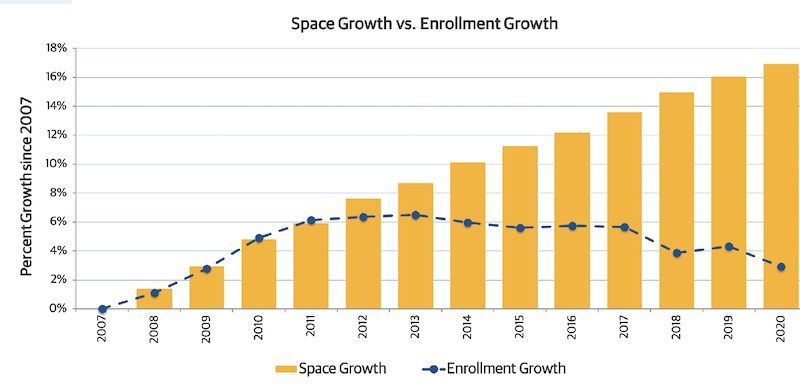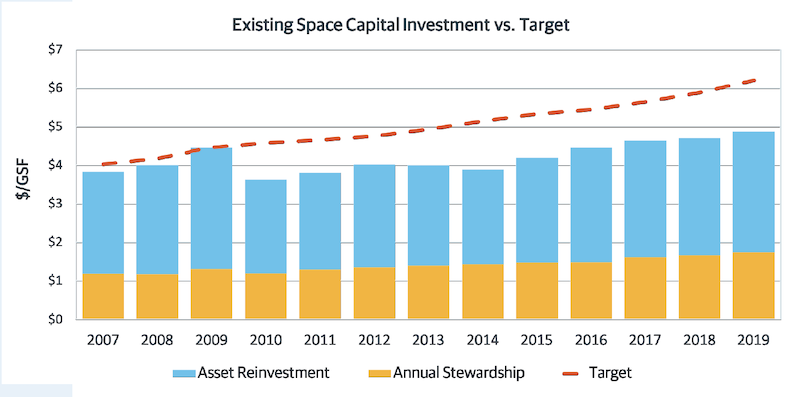As a result of the coronavirus pandemic, higher education is confronting its history of questionable facilities investment decisions and an unprecedented transformation on campuses that has made it imperative to reimagine construction, space allocation, and sustainability.
Gordian, a leading provider of facility and construction cost data, software, and services, analyzes the complexities of this transformation in the latest edition of its State of Facilities in Higher Education report, which this year Gordian conducted with APPA, an organization that represents more than 18,000 educational facilities professionals from over 1,300 learning institutions.
The report advocates for the increasing relevance of facilities managers at a time when campuses are building more space (schools in Gordian’s database were up 16% since 2007), but have also ill-advisedly deferred renovation on existing buildings, to the point where their backlog of asset renewal has increased by 35% since 2007, and their investment shortfall grew to 25%.

Colleges in Gordian's database have increased their space by 16% since 2007, but their student enrollment has increased only 2%. Images: Gordian and APPA
HOW MUCH SPACE WILL BE REQUIRED?
The pandemic has disrupted institutional improvement budgets by reducing student enrollment and shifting learning to remote and digital platforms that have lessened the need for campus spaces such as offices, dining halls, and residences. Outdoor spaces “were the rare bright spot, when weather has allowed,” the report states.
Consequently, campus planners are raising questions about what kinds of spaces will be needed in the future, and why. But adaptively reusing campus space is easier said than done. “Facilities offices aren’t sized and organized to maintain, clean and renovate according to student and staff activity. Rather, these offices maintain campus buildings independent of activity level,” the report observes.
Finding ways to fund facilities improvements and upgrades won’t be simple, either. The American Council on Education projects that the industry needs at least $180 billion to offset revenue losses and COVID-related expenses to maintain safe operations during the pandemic. But with between 50% and 70% of campus expenditures earmarked for employee compensation, the opportunities for addressing budget shortfalls without touching staffing are limited. For the whole of 2020, the industry lost 650,000 jobs.

Backlogs of campuses' asset renewal needs have grown to $106 per gross sf, and 35% increase since 2007.
WHAT DOES ‘COMMUNITY’ MEAN TODAY?
The report notes that in the 2020 fall semester, 44% of schools were fully or primarily online, with another 21% operating in hybrid teaching mode. However, Gordian and APPA contend that the virtual world is not yet able to replace the in-person [educational] experience. “Community continues to be reliant on the physical gatherings of people, which will be an expected element of the collegiate experience for some time to come.”
If schools can’t provide this meaningful engagement, as well as some demonstrable evidence of a return on students’ investment, enrollments will continue to drop. The 13% decline in last year’s incoming freshman class “will have a ripple effect across the next three to five years,” the report states.
And schools can no longer rely on international students to help bridge their financial gaps.
The whole concept of campus “community” is changing. And the sudden embrace of digital tools for teaching opens endless interpretations of what an academic community looks like. “An opportunity clearly exists to reimagine campus space. The window is open to embrace digital, distant and trust-based work environments, and [schools] should leap to take advantage of the moment.”
More to the point, “the data say we need to use less space because [schools] simply can’t care for what [they’ve] built,” says the report.

The investment shortfall in existing campus facilities has grown to 25% over the past 13 years.
HARD CHOICES WILL BE NECESSARY
So what are colleges and universities to do?
A start would be to document real operating costs, including the accrual of deferred needs with altered staffing and reduced capital investment. Facilities managers must prioritize space going forward, and clarify how students are likely to be taught. “Create a coherent narrative, incorporating the expectations of the community and the demands of the facilities, that represents a shared agreement for how to best optimize service to academic aspirations and institutional mission.”
Regarding future investments, schools must define their risk tolerances, especially it comes to keeping building systems operable to avoid shutdowns. Finance and facilities leaders must jointly understand how best to invest in a school’s physical plant, and develop a suitable investment strategy based on future need. That strategy, states the report, should have buy-in from the school’s senior leadership as well as stakeholders—students, faculty, workers—who will be affected by those decisions.
To meet the challenges of more dynamic campuses with fluid spaces and use, the report suggests that, at a minimum, institutions need to honestly appraise their facilities management teams, and determine what skills they will need for the next crisis but also routine times.
“Assess the type or work that has been required and is anticipated to be required to match hiring practices with the skills of the future,” the report states.
Related Stories
University Buildings | Oct 15, 2024
Recreation and wellness are bedfellows in new campus student centers
Student demands for amenities and services that address their emotional and mental wellbeing are impacting new development on college campuses that has led to recreation centers with wellness portfolios.
University Buildings | Oct 9, 2024
Des Moines University Medicine and Health Sciences opens a new 88-acre campus
Des Moines University Medicine and Health Sciences has opened a new campus spanning 88 acres, over three times larger than its previous location. Designed by RDG Planning & Design and built by Turner Construction, the $260 million campus features technology-rich, flexible educational spaces that promote innovative teaching methods, expand research activity, and enhance clinical services. The campus includes four buildings connected with elevated pathways and totaling 382,000 sf.
University Buildings | Oct 4, 2024
Renovations are raising higher education campuses to modern standards
AEC higher ed Giants report working on a variety of building types, from performing arts centers and libraries to business schools. Hybrid learning is seemingly here to stay. And where possible, these projects address wellness and mental health concerns.
Museums | Oct 1, 2024
UT Dallas opens Morphosis-designed Crow Museum of Asian Art
In Richardson, Tex., the University of Texas at Dallas has opened a second location for the Crow Museum of Asian Art—the first of multiple buildings that will be part of a 12-acre cultural district. When completed, the arts and performance complex, called the Edith and Peter O’Donnell Jr. Athenaeum, will include two museums, a performance hall and music building, a grand plaza, and a dedicated parking structure on the Richardson campus.
Education Facilities | Sep 16, 2024
Hot classrooms, playgrounds spur K-12 school districts to go beyond AC for cooling
With hotter weather occurring during the school year, school districts are turning to cooling strategies to complement air conditioning. Reflective playgrounds and roads, cool roofs and window films, shade structures and conversion of asphalt surfaces to a natural state are all being tried in various regions of the country.
University Buildings | Sep 4, 2024
UC San Diego’s new Multidisciplinary Life Sciences Building will support research and teaching in both health and biological sciences
The University of California San Diego has approved plans for a new Multidisciplinary Life Sciences Building, with construction starting this fall. The 200,000-sf, six-level facility will be the first building on the UC San Diego campus to bridge health science research with biological science research and teaching.
K-12 Schools | Aug 29, 2024
Designing for dyslexia: How architecture can address neurodiversity in K-12 schools
Architects play a critical role in designing school environments that support students with learning differences, particularly dyslexia, by enhancing social and emotional competence and physical comfort. Effective design principles not only benefit students with dyslexia but also improve the learning experience for all students and faculty. This article explores how key design strategies at the campus, classroom, and individual levels can foster confidence, comfort, and resilience, thereby optimizing educational outcomes for students with dyslexia and other learning differences.
Curtain Wall | Aug 15, 2024
7 steps to investigating curtain wall leaks
It is common for significant curtain wall leakage to involve multiple variables. Therefore, a comprehensive multi-faceted investigation is required to determine the origin of leakage, according to building enclosure consultants Richard Aeck and John A. Rudisill with Rimkus.
K-12 Schools | Aug 8, 2024
New K-12 STEM center hosts robotics learning, competitions in Houston suburb
A new K-12 STEM Center in a Houston suburb is the venue for robotics learning and competitions along with education about other STEM subjects. An unused storage building was transformed into a lively space for students to immerse themselves in STEM subjects. Located in Texas City, the ISD Marathon STEM and Robotics Center is the first of its kind in the district.
Education Facilities | Aug 4, 2024
A former supersonic wind tunnel becomes a new educational facility for transportation design
The Mullin Transportation Design Center at ArtCenter College of Design in Pasadena, Calif., provides access for full-scale vehicular models, replicating a professional design studio.

















